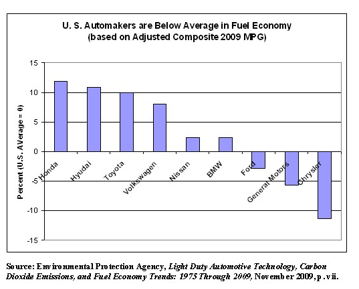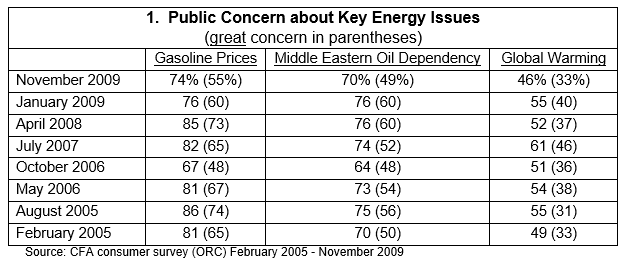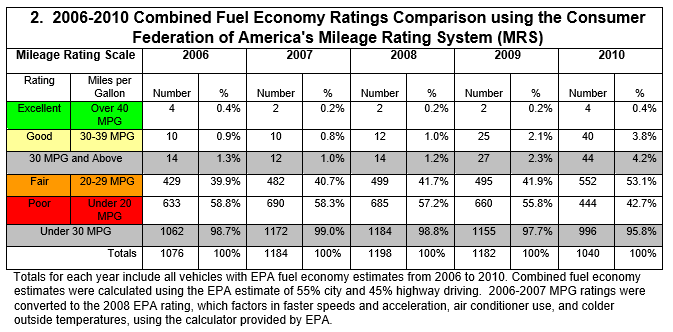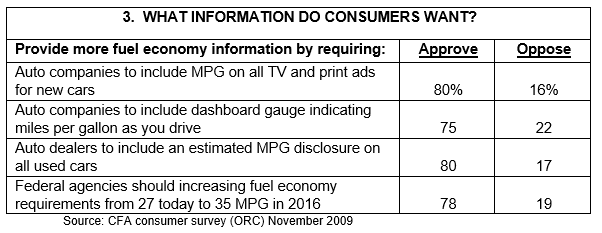Washington, D.C. – In advance of one of the biggest driving weekends of the year, the Consumer Federation of America (CFA) released its latest energy survey showing that, despite lower gasoline prices, an overwhelming majority of Americans (78%) still support higher vehicle fuel economy standards. The results reflect widespread concern over future gas prices and U.S. oil imports and a consistent demand for less gas guzzling vehicles. In spite of these attitudes, according to new CFA research, only a tiny share (4%) of the 2010 model year vehicles achieves 30 mpg or more. According to Administration rulemaking data, a new CFA analysis finds that automakers can achieve 45 mpg by 2020, at a cost beneficial to consumers.
“This is a case of utter market failure – consumer demand is not being met by vehicle supply,” said Mark Cooper CFA Director of Research. “It’s a vicious cycle that is fueled by the National Highway Transportation Safety Administration because they cannot set long-term aggressive standards. Our research shows that consumers want, and the industry needs for its own survival, higher fuel economy standards.”
EPA Should Take the Lead In Developing New Standards
CFA leaders called on the Obama Administration to put the Environmental Protection Agency (EPA) in charge and set standards to achieve 45 mpg by 2020 and much higher levels in the future to avoid future market failure.
 “There is no question that the EPA should take the lead in developing the next generation of standards for the sake of the consumer and the industry,” continued Cooper.
“There is no question that the EPA should take the lead in developing the next generation of standards for the sake of the consumer and the industry,” continued Cooper.
“NHTSA not only has statutory limits that prevent long-term planning, but they have a history of close alignment with the domestic car companies, whose current financial woes stem from a lack of fuel efficient vehicles. If they were not in such bad shape, NHTSA could have set the 2016 standard at more than 38 mpg. To avoid even greater market failure, and the demise of our domestic industry, EPA needs to set long term aggressive standards. The most recent data from EPA shows that the U.S. automakers continue to lag behind the foreign automakers on fuel economy and the farther behind the individual company, the worse the financial condition they are in.”
“Ironically, foreign based manufacturers are doing a far better job of responding to consumer demand for fuel efficiency than are the U.S. automakers,” said Jack Gillis CFA Director of Public Affairs and author of The Car Book. “Our analysis of model offerings show Asian manufacturers offering nearly twice as many 2010 vehicles getting 30 mpg and above than U.S. companies,” said Gillis.
New Consumer Survey Shows Great Concern About Gas Prices
The new survey found 78 % of Americans support increasing fuel economy standards to 35 mpg by 2016 (See table 3 following). Despite current gas prices below $3 a gallon, a large majority remain concerned about future gas prices (74%) and dependence on Middle-Eastern oil (70%). By comparison, looking to the next five years, 46% are concerned in the short term about global warming. As table 1 below shows, public opinion on these issues has remained consistent over the nearly 5 years of CFA consumer surveys.
“The persistence of widespread concern about gas prices and dependence on oil imports shows a strong base of public support for significant improvements in motor vehicle fuel economy,” said Cooper. “Stronger fuel economy standards not only respond to clear consumer expectations but will be critical to the survival of the U.S. auto industry.”

New CFA Analysis of Administration’s Proposed Rulemaking Shows 45 mpg by 2020 Possible
In the economic analysis released today, CFA shows, using the Administration’s own rulemaking data, that the automobile industry is capable of achieving fleet-wide fuel economy of 45 mpg by 2020 with off-the-shelf technology. Further, if the rate of innovation continues at the same pace as in the over the next decade, as it NHTSA projects for the next six years, constant, automakers could easily achieve much higher standards in the future. Reviewing the economic underpinnings associated with the new standards, it is clear that any costs associated with effective new standards will actually save money, the report concludes.
“The EPA/NHTSA data show that much higher levels of fuel economy than NHTSA/EPA is suggesting will save consumers money from the day they buy the car or truck,” said Cooper. “Any increase in monthly payments is more than offset by monthly gas savings. With costs of efficiency declining and the value of fuel savings rising, this consumer benefit should continue as higher standards are set.”
Car Companies are Still Not Providing the Fuel Efficient Cars Consumer Want
In its latest analysis of the how the new models stack up in fuel economy, CFA discovered that only 4% of the 1,040 EPA rated 2010 models have an overall fuel economy rating of 30 mpg and above.
“Given that the preponderance of fuel inefficient vehicles was a major factor in the crash of the U.S. automobile industry, it is shocking that so few of today’s vehicles get over 30 mpg,” said Jack Gillis. “Clearly an important reason for much, much stronger fuel economy requirements in the future is to protect the car companies from themselves,” added Gillis. “Consumers roaming through new car lots will only find 44 of the 1040 models offering 30 mpg or more.”

Consumers Want More Fuel Economy Information
“During these hard economic times and expecting higher gas prices in the future, consumers are calling out for help,” said Gillis. The CFA survey asked a series of specific questions regarding information consumers want policymakers to provide to improve fuel efficiency and cut gasoline expenses.
Advertising: Consumers support requiring auto companies to include mpg ratings in all TV and print ads for new cars (80%).
Dashboard MPG Gauges: There is much support, 75%, for requiring auto companies to include a dashboard gauge indicating miles per gallon as you drive.
Used Car Mileage Stickers: As mileage disclosures are required on new cars, 80% of Americans think auto dealers should be required to include an estimated MPG disclosure on used cars. With minor modifications, the EPA website could easily enable used car dealers to print out a distinctive label for the vehicles on their lot. “This simple step could instantly empower the 75% of car buyers who buy used versus new vehicles,” said Gillis.

Other Fuel Efficiency Measures Receive Less Support
The public has mixed feelings about establishing price incentives and disincentives to encourage the purchase of fuel-efficient cars. Only 40% support feebates (requiring surcharges for fuel inefficient vehicles and using that revenue to offer rebates to buyers of fuel misers) while 54% oppose them. Only 46% support revenue neutral workplace programs that discourage driving alone to work.

This latest CFA survey was conducted November 12-15th and undertaken by the Opinion Research Corporation. The survey consists of a representative sample of more than 1,000 adult Americans and had a margin of error of +/- 3%.

